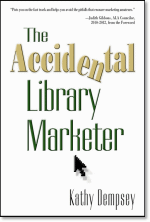
I have never met Kathy Dempsey. Other than sharing the same first name, we have no personal or professional connection. So imagine my total amazement as I read an incredibly accurate description of myself on page four of her book, The Accidental Library Marketer. Under a section called How Accidental Marketers Are Born, Dempsey chronicles the transformation of a librarian with a flair for sign-making who suddenly discovers she is “the marketing person” at her library. Does this sound familiar to you, too? If it does, I highly recommend this book.
Dempsey structures The Accidental Library Marketer to provide both education and practical tools to support and encourage the marketing-by-the-seat-of-the-pants activities of many librarians. The first half of the book explains the foundational need for some marketing knowledge and then encapsulates essential marketing principles into digestible segments. Peppered throughout are real-world examples, tidbits of expert advice, and resources you can use right away. For instance, Chapter 3, “Assessing Your Current Situation,” offers checklists to help you determine how users perceive your library. Dempsey breaks down the assessment process and makes you take a probing look at your physical spaces, online environments, printed materials, and customer service practices.
Another enlightening chapter is “What Marketing Experts Think Is Most Important.” Dempsey gets right to the point, listing five common mistakes:
1. Librarians think they know what their customers want without asking them.
2. Librarians send press releases and promote programs and call it “marketing.”
3. Librarians don’t separate people into different target markets and treat each group differently.
4. Librarians don’t study the people who make up their user bases.
5. Librarians don’t fully evaluate the results of programs and campaigns and then use that data to improve future efforts. (p. 79)
Dempsey examines each of these pitfalls, offering constructive criticism and practical advice along the way. In her conversational tone, the author also shares the wisdom of established experts and introduces the reader to scholars and experienced professionals from around the world. As an English major who avoided business classes like the plague during college, I found this “crash course” particularly helpful. This education is further enriched in subsequent chapters on evidence-based decision making, statistics, and understanding the Cycle of True Marketing.
After completing your micro-bachelor’s degree in marketing, you can get down to business with chapters on developing a formal marketing plan, producing promotional materials, communicating your message, and using your website effectively. My institution already had a formal marketing plan in place when I found myself in the unexpected role of library marketer. However, the chapter called “Writing Your Formal Plans” helped me see my library’s marketing plan with new eyes. A carefully crafted plan drives your promotional activities and focuses your energy and commitment. It is an essential guide for the accidental marketer who must balance and commingle daily responsibilities with library marketing endeavors.
Dempsey offers implementation suggestions throughout the book but also dedicates an entire chapter to programs, fliers, newsletters, and other ideas to initiate outreach. She points out, “too many accidental marketers start here, trying to think of neat stuff to do.... Sadly, this is wrong, wrong, wrong” (p. 224). Previous chapters help you make important decisions about your target markets and how to reach them. This final chapter compiles descriptions of actual library events and success stories. Some are impractical for academic library settings. And, while an earlier chapter supplies a wealth of advice for obtaining institutional and staff buy-in, several ideas would be difficult to initiate without very strong support from administrators and colleagues. Still, the chapter is entertaining and gets the creative juices flowing.
Attempting marketing tasks without a traditional business education and background can be daunting. It is a role many librarians assume because they are natural advocates for libraries. However, they often lack specific training and perform marketing tasks in addition to other responsibilities. But these librarians typically don’t think of marketing as an extra duty. They realize it is a necessity for libraries in our digital world. The About the Author section at the end of the book reveals that Kathy Dempsey “continues to devote her life to educating weenies who think that the internet can replace libraries.” With this handbook and guide, accidental library marketers everywhere can aid in that struggle.
|